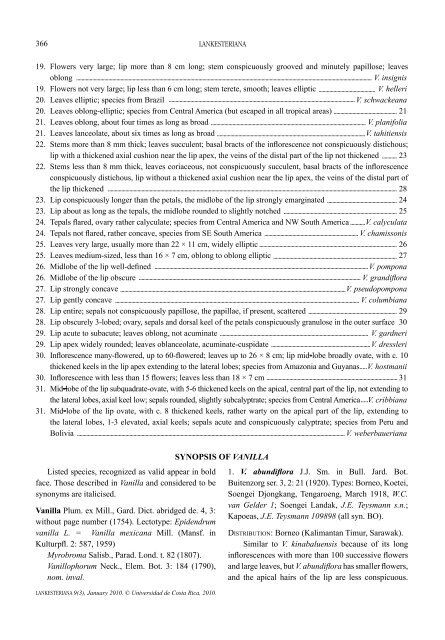A NEW INFRAGENERIC CLASSIFICATION AND SyNOPSIS OF THE ...
A NEW INFRAGENERIC CLASSIFICATION AND SyNOPSIS OF THE ...
A NEW INFRAGENERIC CLASSIFICATION AND SyNOPSIS OF THE ...
You also want an ePaper? Increase the reach of your titles
YUMPU automatically turns print PDFs into web optimized ePapers that Google loves.
366 LANKESTERIANA<br />
19. Flowers very large; lip more than 8 cm long; stem conspicuously grooved and minutely papillose; leaves<br />
oblong V. insignis<br />
19. Flowers not very large; lip less than 6 cm long; stem terete, smooth; leaves elliptic V. helleri<br />
20. Leaves elliptic; species from Brazil V. schwackeana<br />
20. Leaves oblong-elliptic; species from Central America (but escaped in all tropical areas) 21<br />
21. Leaves oblong, about four times as long as broad V. planifolia<br />
21. Leaves lanceolate, about six times as long as broad V. tahitiensis<br />
22. Stems more than 8 mm thick; leaves succulent; basal bracts of the inflorescence not conspicuously distichous;<br />
lip with a thickened axial cushion near the lip apex, the veins of the distal part of the lip not thickened 23<br />
22. Stems less than 8 mm thick, leaves coriaceous, not conspicuously succulent, basal bracts of the inflorescence<br />
conspicuously distichous, lip without a thickened axial cushion near the lip apex, the veins of the distal part of<br />
the lip thickened 28<br />
23. Lip conspicuously longer than the petals, the midlobe of the lip strongly emarginated 24<br />
23. Lip about as long as the tepals, the midlobe rounded to slightly notched 25<br />
24. Tepals flared, ovary rather calyculate; species from Central America and NW South America V. calyculata<br />
24. Tepals not flared, rather concave, species from SE South America V. chamissonis<br />
25. Leaves very large, usually more than 22 × 11 cm, widely elliptic 26<br />
25. Leaves medium-sized, less than 16 × 7 cm, oblong to oblong elliptic 27<br />
26. Midlobe of the lip well-defined V. pompona<br />
26. Midlobe of the lip obscure V. grandiflora<br />
27. Lip strongly concave V. pseudopompona<br />
27. Lip gently concave V. columbiana<br />
28. Lip entire; sepals not conspicuously papillose, the papillae, if present, scattered 29<br />
28. Lip obscurely 3-lobed; ovary, sepals and dorsal keel of the petals conspicuously granulose in the outer surface 30<br />
29. Lip acute to subacute; leaves oblong, not acuminate V. gardneri<br />
29. Lip apex widely rounded; leaves oblanceolate, acuminate-cuspidate V. dressleri<br />
30. Inflorescence many-flowered, up to 60-flowered; leaves up to 26 × 8 cm; lip mid-lobe broadly ovate, with c. 10<br />
thickened keels in the lip apex extending to the lateral lobes; species from Amazonia and Guyanas V. hostmanii<br />
30. Inflorescence with less than 15 flowers; leaves less than 18 × 7 cm 31<br />
31. Mid-lobe of the lip subquadrate-ovate, with 5-6 thickened keels on the apical, central part of the lip, not extending to<br />
the lateral lobes, axial keel low; sepals rounded, slightly subcalyptrate; species from Central America V. cribbiana<br />
31. Mid-lobe of the lip ovate, with c. 8 thickened keels, rather warty on the apical part of the lip, extending to<br />
the lateral lobes, 1-3 elevated, axial keels; sepals acute and conspicuously calyptrate; species from Peru and<br />
Bolivia V. weberbaueriana<br />
Listed species, recognized as valid appear in bold<br />
face. Those described in Vanilla and considered to be<br />
synonyms are italicised.<br />
Vanilla Plum. ex Mill., Gard. Dict. abridged de. 4, 3:<br />
without page number (1754). Lectotype: Epidendrum<br />
vanilla L. = Vanilla mexicana Mill. (Mansf. in<br />
Kulturpfl. 2: 587, 1959)<br />
Myrobroma Salisb., Parad. Lond. t. 82 (1807).<br />
Vanillophorum Neck., Elem. Bot. 3: 184 (1790),<br />
nom. inval.<br />
LANKESTERIANA 9(3), January 2010. © Universidad de Costa Rica, 2010.<br />
<strong>SyNOPSIS</strong> <strong>OF</strong> VANILLA<br />
1. V. abundiflora J.J. Sm. in Bull. Jard. Bot.<br />
Buitenzorg ser. 3, 2: 21 (1920). Types: Borneo, Koetei,<br />
Soengei Djongkang, Tengaroeng, March 1918, W.C.<br />
van Gelder 1; Soengei Landak, J.E. Teysmann s.n.;<br />
Kapoeas, J.E. Teysmann 109898 (all syn. BO).<br />
distribution: Borneo (Kalimantan Timur, Sarawak).<br />
Similar to V. kinabaluensis because of its long<br />
inflorescences with more than 100 successive flowers<br />
and large leaves, but V. abundiflora has smaller flowers,<br />
and the apical hairs of the lip are less conspicuous.

















